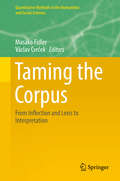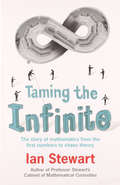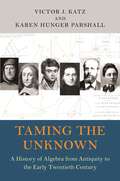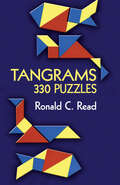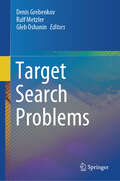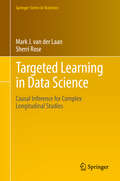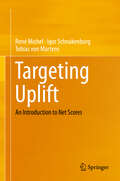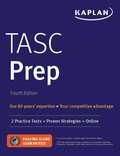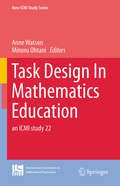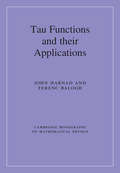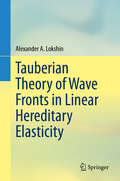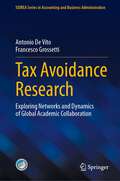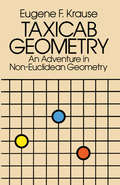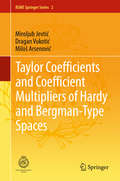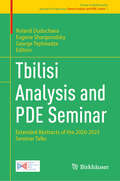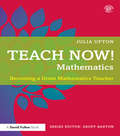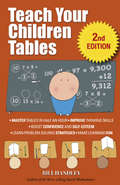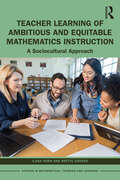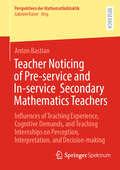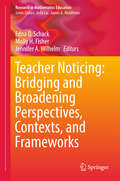- Table View
- List View
Tamil Nadu Government Standard 7 Tamil Medium - Second Term - Mathematics
by Tamil Nadu GovernmentTamil Nadu Government Standard 7 Tamil Medium,Second Term sylabus for the subject Mathematics.
Tamil Nadu Government Standard 8 Tamil Medium - Second Term - Mathematics
by Tamil Nadu GovernmentTamil Nadu Government Standard 8 Tamil Medium,Second Term sylabus for the subject Mathematics.
Taming the Corpus: From Inflection and Lexis to Interpretation (Quantitative Methods in the Humanities and Social Sciences)
by Masako Fidler Václav CvrčekThis book bridges the current quantitative and qualitative text analyses, using grammar as a crucial source of investigation. Taking data from Czech, an inflected language, in which the most optimal conditions to respond to this research question are met, the book expands the understanding of language and text in ways that have not been executed before. For predominantly English-based quantitative research, this volume fills a crucial gap by examining the relationship between inflection and other phenomena (including discourse, translation and literature). For the current qualitative research, the volume provides large empirical data to confirm some of its claims, but more importantly, it demonstrates the important role of detailed grammatical concepts that have not been considered before. Besides addressing fundamental questions about text analysis methods, the volume presents a diverse array of Czech data that are unique in their own right and worthy of dissemination to the general audience. Taming the Corpus: From Inflection and Lexis to Interpretation is divided into three sections. Section 1 deals with phonotactics, poetic structure, morphological complexity used to differentiate literary style, and native speakers’ sense of grammaticality – issues pertinent to linguistic typology, cognition and language, and literary studies. Section 2 focuses on inter-language relations, especially the theory of translation. Section 3 demonstrates how quantitative analysis of texts can contribute to our understanding of society and connects the volume to legal language, construction of gender and discourse position and implicit ideology.
Taming the Infinite
by Ian StewartFrom ancient Babylon to the last great unsolved problems, Ian Stewart brings us his definitive history of mathematics. In his famous straightforward style, Professor Stewart explains each major development--from the first number systems to chaos theory--and considers how each affected society and changed everyday life forever.Maintaining a personal touch, he introduces all of the outstanding mathematicians of history, from the key Babylonians, Greeks and Egyptians, via Newton and Descartes, to Fermat, Babbage and Godel, and demystifies math's key concepts without recourse to complicated formulae. Written to provide a captivating historic narrative for the non-mathematician, Taming the Infinite is packed with fascinating nuggets and quirky asides, and contains 100 illustrations and diagrams to illuminate and aid understanding of a subject many dread, but which has made our world what it is today.
Taming the Unknown: A History of Algebra from Antiquity to the Early Twentieth Century
by Karen Hunger Parshall Victor J. KatzWhat is algebra? For some, it is an abstract language of x's and y’s. For mathematics majors and professional mathematicians, it is a world of axiomatically defined constructs like groups, rings, and fields. Taming the Unknown considers how these two seemingly different types of algebra evolved and how they relate. Victor Katz and Karen Parshall explore the history of algebra, from its roots in the ancient civilizations of Egypt, Mesopotamia, Greece, China, and India, through its development in the medieval Islamic world and medieval and early modern Europe, to its modern form in the early twentieth century.Defining algebra originally as a collection of techniques for determining unknowns, the authors trace the development of these techniques from geometric beginnings in ancient Egypt and Mesopotamia and classical Greece. They show how similar problems were tackled in Alexandrian Greece, in China, and in India, then look at how medieval Islamic scholars shifted to an algorithmic stage, which was further developed by medieval and early modern European mathematicians. With the introduction of a flexible and operative symbolism in the sixteenth and seventeenth centuries, algebra entered into a dynamic period characterized by the analytic geometry that could evaluate curves represented by equations in two variables, thereby solving problems in the physics of motion. This new symbolism freed mathematicians to study equations of degrees higher than two and three, ultimately leading to the present abstract era.Taming the Unknown follows algebra’s remarkable growth through different epochs around the globe.
Tangrams: 330 Puzzles (Dover Recreational Math)
by Ronald C. ReadThis collection gathers together nearly 330 tangrams, the best creations of both Chinese and Occidental puzzle devisers. Included are puzzles carefully selected from rare 19th-century books and some of the most inventive and imaginative inventions of Loyd and Dudeney. Tangrams range from the relatively easy to the difficult.
Target Search Problems
by Denis Grebenkov Ralf Metzler Gleb OshaninThis book presents cutting-edge research addressing the mathematical models used to tackle the "Target problem" as it manifests itself in a wide range of disciplines. Leading international experts from around the world describe a variety of different approaches to this truly multidisciplinary topic. Recent years have witnessed a substantial and still growing interest in understanding the general "Target problem". This encompasses a wide range of different situations in which some "agents" perform a deterministic or stochastic motion to search for a certain immobile or mobile "target". Such problems arise in many disciplines: to name but a few, computer science, the evolution of stock markets, biochemistry, bio-medicine, evolutionary games, as well as diverse areas of physics. This book with its up-to-date collection of chapters authored by leading experts in these and other fields, provides a comprehensive and complete picture in broadlyaccessible language. The book will naturally serve as a source of inspiration for further research, as well as facilitating a cross-fertilization of approaches, ideas, and research directions.
Targeted Learning in Data Science: Causal Inference For Complex Longitudinal Studies (Springer Series in Statistics)
by Mark J. van der Laan Sherri RoseThis textbook for graduate students in statistics, data science, and public health deals with the practical challenges that come with big, complex, and dynamic data. It presents a scientific roadmap to translate real-world data science applications into formal statistical estimation problems by using the general template of targeted maximum likelihood estimators. These targeted machine learning algorithms estimate quantities of interest while still providing valid inference. Targeted learning methods within data science area critical component for solving scientific problems in the modern age. The techniques can answer complex questions including optimal rules for assigning treatment based on longitudinal data with time-dependent confounding, as well as other estimands in dependent data structures, such as networks. Included in Targeted Learning in Data Science are demonstrations with soft ware packages and real data sets that present a case that targeted learning is crucial for the next generation of statisticians and data scientists. Th is book is a sequel to the first textbook on machine learning for causal inference, Targeted Learning, published in 2011.Mark van der Laan, PhD, is Jiann-Ping Hsu/Karl E. Peace Professor of Biostatistics and Statistics at UC Berkeley. His research interests include statistical methods in genomics, survival analysis, censored data, machine learning, semiparametric models, causal inference, and targeted learning. Dr. van der Laan received the 2004 Mortimer Spiegelman Award, the 2005 Van Dantzig Award, the 2005 COPSS Snedecor Award, the 2005 COPSS Presidential Award, and has graduated over 40 PhD students in biostatistics and statistics.Sherri Rose, PhD, is Associate Professor of Health Care Policy (Biostatistics) at Harvard Medical School. Her work is centered on developing and integrating innovative statistical approaches to advance human health. Dr. Rose’s methodological research focuses on nonparametric machine learning for causal inference and prediction. She co-leads the Health Policy Data Science Lab and currently serves as an associate editor for the Journal of the American Statistical Association and Biostatistics.
Targeting Uplift: An Introduction to Net Scores
by René Michel Igor Schnakenburg Tobias von MartensThis book explores all relevant aspects of net scoring, also known as uplift modeling: a data mining approach used to analyze and predict the effects of a given treatment on a desired target variable for an individual observation. After discussing modern net score modeling methods, data preparation, and the assessment of uplift models, the book investigates software implementations and real-world scenarios. Focusing on the application of theoretical results and on practical issues of uplift modeling, it also includes a dedicated chapter on software solutions in SAS, R, Spectrum Miner, and KNIME, which compares the respective tools. This book also presents the applications of net scoring in various contexts, e.g. medical treatment, with a special emphasis on direct marketing and corresponding business cases. The target audience primarily includes data scientists, especially researchers and practitioners in predictive modeling and scoring, mainly, but not exclusively, in the marketing context.
Tasc Prep: 2 Practice Tests + Proven Strategies + Online (Kaplan Test Prep)
by Kaplan Test PrepA mathematics and statistics book.
Task Design In Mathematics Education
by Anne Watson Minoru OhtaniThis book is the product of ICMI Study 22 Task Design in Mathematics Education. The study offers a state-of-the-art summary of relevant research and goes beyond that to develop new insights and new areas of knowledge and study about task design. The authors represent a wide range of countries and cultures and are leading researchers, teachers and designers. In particular, the authors develop explicit understandings of the opportunities and difficulties involved in designing and implementing tasks and of the interfaces between the teaching, researching and designing roles - recognising that these might be undertaken by the same person or by completely separate teams. Tasks generate the activity through which learners meet mathematical concepts, ideas, strategies and learn to use and develop mathematical thinking and modes of enquiry. Teaching includes the selection, modification, design, sequencing, installation, observation and evaluation of tasks. The book illustrates how task design is core to effective teaching, whether the task is a complex, extended, investigation or a small part of a lesson; whether it is part of a curriculum system, such as a textbook, or promotes free standing activity; whether the task comes from published source or is devised by the teacher or the student.
Task Design In Mathematics Education: an ICMI study 22 (New ICMI Study Series #17)
by Anne Watson Minoru Ohtani*THIS BOOK WILL SOON BECOME AVAILABLE AS OPEN ACCESS BOOK*This open access book is the product of ICMI Study 22 Task Design in Mathematics Education. The study offers a state-of-the-art summary of relevant research and goes beyond that to develop new insights and new areas of knowledge and study about task design. The authors represent a wide range of countries and cultures and are leading researchers, teachers and designers. In particular, the authors develop explicit understandings of the opportunities and difficulties involved in designing and implementing tasks and of the interfaces between the teaching, researching and designing roles – recognising that these might be undertaken by the same person or by completely separate teams. Tasks generate the activity through which learners meet mathematical concepts, ideas, strategies and learn to use and develop mathematical thinking and modes of enquiry. Teaching includes the selection, modification, design, sequencing, installation, observation and evaluation of tasks. The book illustrates how task design is core to effective teaching, whether the task is a complex, extended, investigation or a small part of a lesson; whether it is part of a curriculum system, such as a textbook, or promotes free standing activity; whether the task comes from published source or is devised by the teacher or the student.
Tau Functions and their Applications (Cambridge Monographs on Mathematical Physics)
by John Harnad Ferenc BaloghTau functions are a central tool in the modern theory of integrable systems. This volume provides a thorough introduction, starting from the basics and extending to recent research results. It covers a wide range of applications, including generating functions for solutions of integrable hierarchies, correlation functions in the spectral theory of random matrices and combinatorial generating functions for enumerative geometrical and topological invariants. A self-contained summary of more advanced topics needed to understand the material is provided, as are solutions and hints for the various exercises and problems that are included throughout the text to enrich the subject matter and engage the reader. Building on knowledge of standard topics in undergraduate mathematics and basic concepts and methods of classical and quantum mechanics, this monograph is ideal for graduate students and researchers who wish to become acquainted with the full range of applications of the theory of tau functions.
Tauberian Theory of Wave Fronts in Linear Hereditary Elasticity
by Alexander A. LokshinThe objective of this book is to construct a rigorous mathematical approach to linear hereditary problems of wave propagation theory and demonstrate the efficiency of mathematical theorems in hereditary mechanics. By using both real end complex Tauberian techniques for the Laplace transform, a classification of near-front asymptotics of solutions to considered equations is given—depending on the singularity character of the memory function. The book goes on to derive the description of the behavior of these solutions and demonstrates the importance of nonlinear Laplace transform in linear hereditary elasticity. This book is of undeniable value to researchers working in areas of mathematical physics and related fields.
Tax Avoidance Research: Exploring Networks and Dynamics of Global Academic Collaboration (SIDREA Series in Accounting and Business Administration)
by Antonio De Vito Francesco GrossettiThis book explores the intricate realm of tax avoidance, synthesizing existing empirical literature in the field. The work starts by exploring the theoretical underpinnings of tax avoidance, dissecting its unique features compared to tax evasion. It delves into measurement methodologies and dissects the determinants contributing to its prevalence. Moreover, it analyzes the economic consequences of tax avoidance, emphasizing its impact on critical accounting issues, including financial reporting transparency, cost of capital, and firm value. Next, the book offers a foundational understanding of graph theory, unveiling the core elements of networks, such as nodes and edges. The book covers the theoretical fundamentals and addresses the practical side of constructing networks based on real-world relational systems. It emphasizes the importance of effective data collection and representation methods and underscores the importance of optimizing network layouts for enhanced visual representation. Using network analysis, the book further offers a deep dive into empirical studies on tax avoidance over the past two decades, revealing insights into the collaborative nature of this stream of research. Finally, the book summarizes the key insights of the network analysis on tax avoidance. It underscores the dynamic nature of individual authors' roles and affiliations, shedding light on the collaborative dynamics within institutions.
Taxicab Geometry: An Adventure in Non-Euclidean Geometry
by Eugene F. KrauseThis entertaining, stimulating textbook offers anyone familiar with Euclidean geometry -- undergraduate math students, advanced high school students, and puzzle fans of any age -- an opportunity to explore taxicab geometry, a simple, non-Euclidean system that helps put Euclidean geometry in sharper perspective.In taxicab geometry, the shortest distance between two points is not a straight line. Distance is not measured as the crow flies, but as a taxicab travels the "grid" of the city street, from block to block, vertically and horizontally, until the destination is reached. Because of this non-Euclidean method of measuring distance, some familiar geometric figures are transmitted: for example, circles become squares.However, taxicab geometry has important practical applications. As Professor Krause points out, "While Euclidean geometry appears to be a good model of the 'natural' world, taxicab geometry is a better model of the artificial urban world that man has built."As a result, the book is replete with practical applications of this non-Euclidean system to urban geometry and urban planning -- from deciding the optimum location for a factory or a phone booth, to determining the most efficient routes for a mass transit system.The underlying emphasis throughout this unique, challenging textbook is on how mathematicians think, and how they apply an apparently theoretical system to the solution of real-world problems.
Taylor Coefficients and Coefficient Multipliers of Hardy and Bergman-Type Spaces
by Miroljub Jevtić Dragan Vukotić Miloš ArsenovićThis book provides a systematic overview of the theory of Taylor coefficients of functions in some classical spaces of analytic functions and especially of the coefficient multipliers between spaces of Hardy type. Offering a comprehensive reference guide to the subject, it is the first of its kind in this area. After several introductory chapters covering the basic material, a large variety of results obtained over the past 80 years, including the most recent ones, are treated in detail. Several chapters end with discussions of practical applications and related topics that graduate students and experts in other subjects may find useful for their own purposes. Thus, a further aim of the book is to communicate to non-specialists some concrete facts that may be of value in their own work. The book can also be used as a textbook or a supplementary reference for an advanced graduate course. It is primarily intended for specialists in complex and functional analysis, graduate students, and experts in other related fields.
Tbilisi Analysis and PDE Seminar: Extended Abstracts of the 2020-2023 Seminar Talks (Trends in Mathematics #7)
by Eugene Shargorodsky Roland Duduchava George TephnadzeThe aim of this volume is to present some new developments and ideas in partial differential equations and mathematical analysis, including spectral analysis and boundary value problems for PDE, harmonic analysis, inequalities, integral equations, and applications. This book is a collection of short summaries of reports from lectures delivered at Tbilisi Analysis & PDE seminars and workshops. In particular, it contains some applications and several open questions aimed at inspiring further research. The volume contains 21 research articles.
Teach Now! Mathematics: Becoming a Great Mathematics Teacher (Teach Now!)
by Julia UptonBeing taught by a great teacher is one of the great privileges of life. Teach Now! is an exciting new series that opens up the secrets of great teachers and, step-by-step, helps trainees to build the skills and confidence they need to become first-rate classroom practitioners. Written by a highly-skilled practitioner, this practical, classroom-focused guide contains all the support you need to become a great mathematics teacher. Combining a grounded, modern rationale for learning and teaching with highly practical training approaches, the book guides you through the themes of mathematics teaching and the skills needed to demonstrate learning. Teach Now! Mathematics also offers clear, straightforward advice on classroom practice, lesson planning and working in schools. Teaching and learning, planning, assessment and behaviour management are all covered in detail, with a host of carefully chosen examples used to demonstrate good practice. Every example is rooted in recent experience in the mathematics classroom. The commonalities of teaching pedagogy across all subjects are discussed but this book gets to the heart of the unique nature of this subject. From building confidence to developing problem-solving skills and mathematical literacy, this book considers what the keys to success are in learning, and hence teaching, mathematics. There are also chapters on dealing with pressure, excelling in observations, finding the right job and succeeding at interview. Throughout the book, there is a great selection of ready-to-use activities, strategies and techniques which will help put you on the fast track to success in the classroom. With a strong emphasis on sparking students' interest and enthusiasm in mathematics, this book is your essential guide as you start your exciting and rewarding career as an outstanding mathematics teacher.
Teach Your Children Tables: How To Blitz Tests And Succeed In Mathematics For Life
by Bill HandleyBill Handley is well known for making maths fun! The first edition of Teach Your Children Tables challenged over 20000 readers -- and Bill has been inundated with letters of thanks since from parents whose children have quickly become proficient in maths and problem solving. This not only pleases their teachers but does wonders for a child's self-esteem. In this new, fully revised edition, rewritten for clearer understanding, Bill expands the sections on explaining multiplication to young children, on problem solving, and the correlation between the multiplication method and subtraction.
Teacher Learning of Ambitious and Equitable Mathematics Instruction: A Sociocultural Approach (Studies in Mathematical Thinking and Learning Series)
by Ilana Horn Brette GarnerDrawing on sociocultural learning theory, this book offers a groundbreaking theory of secondary mathematics teacher learning in schools, focusing on the transformation of instruction as a conceptual change project to achieve ambitious and equitable mathematics teaching. Despite decades of research showing the importance of ambitious and equitable teaching, few inroads have been made in most U.S. classrooms, and teacher learning in general remains undertheorized in most educational research. Illustrating their theory through closely documented case studies of secondary mathematics teachers’ learning and instructional practices, authors Horn and Garner explore the key conceptual issues teachers are required to work through in order to more fully realize ambitious and equitable teaching in their classrooms. By theorizing teacher learning from a sociocultural perspective and focusing on instructional practice, the authors make a unique contribution to the field of teacher learning. This book offers researchers, scholars, and teacher educators new theoretical and methodological tools for the elusive phenomenon of teacher learning, and provides instructional leaders and coaches with practical examples of how teachers shift their thinking and practice.
Teacher Learning of Ambitious and Equitable Mathematics Instruction: A Sociocultural Approach (Studies in Mathematical Thinking and Learning Series)
by Ilana Horn Brette GarnerDrawing on sociocultural learning theory, this book offers a groundbreaking theory of secondary mathematics teacher learning in schools, focusing on the transformation of instruction as a conceptual change project to achieve ambitious and equitable mathematics teaching.Despite decades of research showing the importance of ambitious and equitable teaching, few inroads have been made in most U.S. classrooms, and teacher learning in general remains undertheorized in most educational research. Illustrating their theory through closely documented case studies of secondary mathematics teachers’ learning and instructional practices, authors Horn and Garner explore the key conceptual issues teachers are required to work through in order to more fully realize ambitious and equitable teaching in their classrooms. By theorizing teacher learning from a sociocultural perspective and focusing on instructional practice, the authors make a unique contribution to the field of teacher learning.This book offers researchers, scholars, and teacher educators new theoretical and methodological tools for the elusive phenomenon of teacher learning, and provides instructional leaders and coaches with practical examples of how teachers shift their thinking and practice.
Teacher Noticing of Pre-service and In-service Secondary Mathematics Teachers: Influences of Teaching Experience, Cognitive Demands, and Teaching Internships on Perception, Interpretation, and Decision-making (Perspektiven der Mathematikdidaktik)
by Anton BastianIn light of increasing demands on teachers and the need to develop teaching-related competences, this book examines the situation-specific skill of teacher noticing in pre-service and in-service secondary mathematics teachers. A video-based test instrument is used to measure teachers’ noticing skills in perception, interpretation, and decision-making from both general and mathematics pedagogical perspectives. The aim is to understand the structure and characteristics of teacher noticing across different groups, as well as the influences of teaching experience and opportunities to learn. Three quantitative studies are conducted: two cross-sectional studies with 457 participants, including master’s students, early career teachers, and experienced teachers, and one longitudinal study with 175 master’s students. The results support the conceptualization of teacher noticing as comprising three facets. They also reveal positive influences of teaching experience on the development of teacher noticing, with in-service teachers outperforming master’s students. However, experienced teachers perform similarly to early career teachers in general and worse in certain areas, suggesting saturation or forgetting effects. The longitudinal study finds that interpretation skills facilitate the development of perception and decision-making, emphasizing the knowledge-based nature of teacher noticing.
Teacher Noticing: Bridging and Broadening Perspectives, Contexts, and Frameworks
by Edna O. Schack Molly H. Fisher Jennifer A. WilhelmThis book reflects on the continuing development of teacher noticing through an exploration of the latest research. The authors and editors seek to clarify the construct of teacher noticing and its related branches and respond to challenges brought forth in earlier research. The authors also investigate teacher noticing in multiple contexts and frameworks, including mathematics, science, international venues, and various age groups.
Teachers Have It Easy
by Dave Eggers Henry Louis Gates Ninive Clements Calegari Daniel MoulthropSince its initial publication and multiple reprints in hardcover in 2005, Teachers Have It Easy has attracted the attention of teachers nationwide, appearing on the New York Times extended bestseller list, C-SPAN, and NPR's Marketplace, in addition to receiving strong reviews nationwide. Now available for the first time in paperback, this groundbreaking book examines how bad policy makes teachers' lives miserable.Many teachers today must work two or more jobs to survive; they cannot afford to buy homes or raise families. Interweaving teachers' voices from across the country with hard-hitting facts and figures, this book is a clear-eyed view of the harsh realities of public school teaching, without chicken-soup-for-the-soul success stories.With a look at the problems of recruitment and retention, the myths of short workdays and endless summer vacations, the realities of the work week, and shocking examples of how society views America's teachers, Teachers Have It Easy explores the best ways to improve public education and transform our schools.

